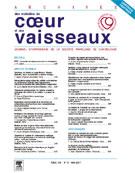05-50 - PREVALENCE OF PATENT FORAMEN OVALE IN CARCINOID SYNDROME AND POTENTIAL USE OF PERCUTANEOUS CLOSURE DEVICE - 09/04/08
Nicolas Mansencal [1],
Emmanuel Mitry [1],
Céline Lepère [1],
Iradj Gandjbakhch [1],
Pascal Lacombe [1],
Philippe Rougier [1],
Olivier Dubourg [1]
Voir les affiliationsBackground: Digestive endocrine tumor may induce carcinoid heart disease (CHD) characterized by valvular heart disease. Patent foramen ovale (PFO) is mainly involved in the pathology of left-sided CHD. The aim of this prospective study was to assess the incidence of PFO in a population of carcinoid syndrome as compared with a control group and the feasibility of percutaneous closure device in selected pts with CHD.
Methods: We prospectively studied 108 pts: 54 pts with carcinoid syndrome and an age- and sex-matched control group (n = 54). Conventionnal echocardiography was used for the detection of right- and left-CHD and PFO was assessed using contrast transthoracic echocardiography, as previously reported. Pts with clinical signs of cyanosis, CHD and significant PFO were referred for percutaneous closure of the PFO.
Results: The prevalence of right- and left-CHD was respectively 54% (29 pts) and 24% (13 pts). The prevalence of PFO was 41% in pts with carcinoid syndrome versus 22% in control group (p = 0.03). Among pts with carcinoid syndrome and PFO (n = 22), 17 pts had an CHD (78%). Furthermore, among pts with CHD (n = 29), the incidence of PFO was significantly higher (59% versus 20% in pts with carcinoid syndrome but without CHD, p = 0.009). Four pts (7% of carcinoid syndrome and 14% of pts with CHD) presented CHD, PFO and cyanosis but one patient was declined for percutaneous transcatheter closure because of short-term bad prognosis. The Amplatzer Septal Occluder was successfully implanted in each patient, as confirmed by fluoroscopic guidance. At 6-month follow-up, a minimal right-to-left shunt persisted in 2 pts and one patient had a severe right-to-left shunt associated with massive tricuspid regurgitation. However, the closure of PFO was associated with an improvement of NHYA functional class in all pts.
Conclusion: Our results suggest that the prevalence of PFO in pts with carcinoid syndrome is higher than in a population of healthy pts. Percutaneous closure of PFO in pts presenting with carcinoid syndrome, cyanosis and significant PFO is feasible and could be proposed in selected pts.
© 2007 Elsevier Masson SAS. Tous droits réservés.
Vol 100 - N° 12
P. 1085 - décembre 2007 Retour au numéroBienvenue sur EM-consulte, la référence des professionnels de santé.

